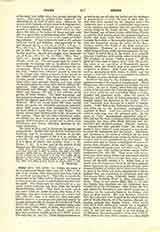

Cedar (Heb. QRR, Qedar; Gr. K?dar), the name of the second son of Ismael (Gen., xxv, 13; I Par., i, 29); also of an Arabian tribe descended from him, and of the territory occupied by it. This tribe is repeatedly mentioned in the Bible and in Assyrian inscriptions; in these latter the people is called Qidrai and the country Qidri. The Cedarenes are represented as a nomadic people differing but little from the modern desert-dwelling Arabs. They lived in tents, which are called black no doubt because, like those of the bedouin, they were made of goat’s and camel’s hair (Jer., xlix, 29; Cant., i, 4-Heb. 5); they were gathered in hacerim or encampments protected merely by a rough enclosure like the douars of the tribes of North Africa (Is., xlii, 11, Heb.); they possessed many camels and much other cattle, in which they carried on a trade with Tyre (Jer., xlix, 29; Ezech., xxvii, 21); they were a restless, warlike people and skillful archers (Ps. cxix, 5 sq.; Is., xxi,17). These frequent references, as well as the use of Cedar for Arabia and the Arabians in general [Cant., i, 4 (5); Ps. cxix, 5], show that before they were crushed by the Assyrian power the Cedarenes were a people of considerable importance. In the Assyrian inscriptions they are associated with certain kings of the Arabs (Aribi). From the fact that Hazael, one of them, is once called King of Cedar in cylinder B of Assurbanipal, the conclusion has been drawn that these kings were Cedarenes, and that towards the middle of the seventh century B.C. Cedar held the hegemony among the tribes of the Syro-Arabian desert—the Arabs of the Bible and of the inscriptions. However, as a certain Ammuladi is called King of Cedar, while his contemporary Ya’uta’ or Uaite’ is styled King of the Arabs, it is probable that the Cedarenes were merely allies of these kings. The prophecy of Isaias, “within a year … all the glory of Cedar shall be taken away” (xxi, 16), probably refers to an expedition of Sennacherib against Hazael, when the latter’s gods were carried by the conqueror to Ninive. Still, Cedar may possibly be as synonymous with Arabs, in which case the prophecy may refer to the severe punishment inflicted by Sargon on some Arabian tribes.
However this may be, the Cedarenes met with disastrous reverses at the hands of Assurbanipal. When Samas-sum-ukin rebelled against his brother, Ya’uta’ or Uaite’, the son of Hazael, sided with him and sent a force to his aid under the Cedarene generals Abiyate’ and Aimu, while he and Ammuladi, King of Cedar, invaded and plundered Syria. After the taking of Babylon and the death of Samas-sum-ukin, Assurbanipal turned his attention to the Arabs. Uaite’ and Ammuladi were defeated in a series of engagements. Uaite’ fled to the Nabataean for refuge, but was given up to the Assyrians; Ammuladi was captured in Moab. Both were carried to Ninive and chained with dogs near the principal gate. In the place of Uaite’ Assurbanipal appointed Abiyate’, who had led the Arab contingent sent to help Samassum-ukin, but who, after being defeated, had surrendered and obtained pardon. Abiyate’, however, in conjunction with another Uaite’, for whom he seems to have resigned, soon organized a new revolt, in which the Nabataean now also joined. Assurbanipal, hastening to the scene of rebellion by the most direct but most difficult road across the Syrian desert, crushed and almost annihilated the rebel tribes. He carried with him to Ninive a multitude of prisoners, among them Abiyate’, Aimu, and Uaite’, and an immense number of camels, oxen, and other cattle. The Cedarenes met with further reverses under Nabuchodonosor (Jer., xlix, 28). They never fully recovered from these heavy blows and henceforth history is silent concerning them, though their name is mentioned till the fifth century A.D. While there is no doubt that the Cedarenes dwelt in the Syro-Arabian desert, known to the ancients as Arabia Deserta, there is some diversity of opinion about their exact location. As both in the Bible and in the inscriptions of Assurbanipal they are mentioned in connection with the Nabataean (Heb. NBYNT, Nebaioth; Assur. Nabaite), they most probably lived in close proximity to these. Pliny, in fact, states (Hist. Nat., v, 12) that the Cedrei, who doubtless are the Cedarenes, were neighbors of the Nabataean. Now before the Persian period the Nabataeans were settled southeast of Idumsea, on the northern limits of the Hidjaz, with Egra as their capital. We may therefore conclude that the Cedarenes were located in the southwestern part of Arabia Deserta, or of the modern Hamad, extending perhaps into Arabia proper. They would thus have been sufficiently remote for a residence among them to convey the idea of distant exile (Ps. cxix, 5), and yet near enough to be well known to the Hebrews. Theodoret mentions (Patr. Lat., LXXX, 1878) that in his time (fifth century A.D.) they dwelt near Babylon. The religion of the Cedarenes, like that of all pre-Islamitic Arabs, was Sabianism, or worship of the heavenly bodies. Their chief divinity was Atarsamaim, i.e. “Atar [Athtar-Astarte] of the heavens”. In Judith, i, 8, instead of “Cedar” we must probably read “Galaad” with the Septuagint.
F. BECHTEL

